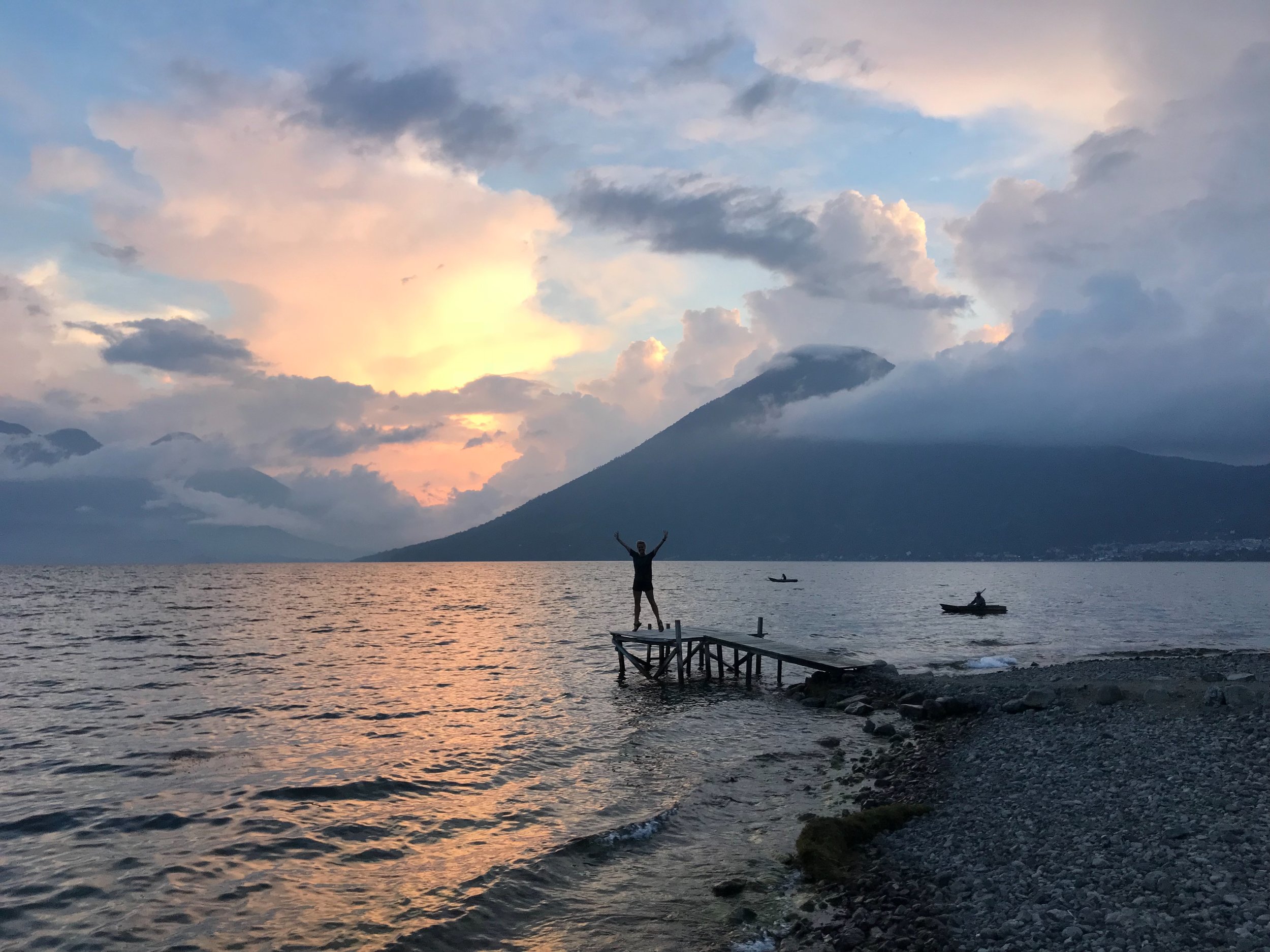LAKE ATITLAN - UNDER THE SURFACE
Located in the south-west highlands, and flanked by a veritable team of volcanoes, Lake Atitlan is one of Guatemala’s most spectacular destinations. Home to Central America’s most breathtaking sunrises & sunsets, it is little surprise that people have fallen in love with the lake for over a thousand years.
We came here to climb a volcano, do some yoga, and stare at the view.
We arrived at dusk into Panajachel, often referred to as the ‘gateway’ to Lake Atitlan, it has the best road & boat links to the rest of the country & lake-side towns respectively. ‘Santander’ (the main street connecting the road to the lake) was a hive of activity; locals & travellers milled around market-stalls, shops, and street-side cafes - their bars & grills set up under leafy pomegranate trees.
We had planned to stay one-night here as a bit of a stop-over before heading to another lake-side town the following morning. After a long day, a border crossing, and too many mini-vans to count, we were glad to crash at the Dreamboat Hostel. Located just 2 minutes from the transfer drop-off point, they sell beers for Q10 (£1), have hot showers (with actual real-life water-pressure) & provide a tank of free Guatamalan coffee each morning. Heaven (relatively speaking).
Now… for those who read the blog, you’ll know what to expect, but for any new readers… brace yourself. Before we get to the normal stuff (where to stay, what to see) you’re in for some full-blown Geography lovin’.
Lake Atitlan has it all - from volcanos & craters to environmental challenges - this is Case Study gold.
So let’s start at the beginning…
How Was it Formed
About 150,000 years ago (give or take 10,000 years) the volcanic activity in the region kicked off in earnest, creating the three original volcanoes - San Marcos, Paquisis, and Tecolote. Sat furtively below, was an enormous chamber of magma.
85,000 years later and things got a little heated… The chamber exploded in a violent plinean eruption known as Los Chocoyos, expelling 270km3 of magma. For a bit of scale - the deadly Mt. Pinatabo eruption of 1991 (the largest in living memory & described as cataclysmic) only expelled 10km3.
The emptied chamber then collapsed in on it-self, creating an enourmous basin around 250 km2. It was filled with water from both the Panajachel & Quiscab Rivers - creating the famous Lago de Atitlán.
The Aitlan, Toliman & San Pedro volcanoes were formed later, giving the lake it’s current dramatic landscape. For anyone a little concerned; San Pedro stopped erupting about 40,000 years ago making it officially extinct, Toliman is believed to still be active (but decidedly unenthusiastic), and Atitlán is awake but lazy - it’s last eruption was 1853 but it is still kept an eye on where it’s still a whippersnapper geologically speaking (only 10,000 years young).
So the lake you speed across in local colectivo boats, and admire placid & steaming in the dawn light, is actually sitting in a monumental volcanic crater. Love it.
Sadly not all that glitters is gold…
Environmental Issues
Nasa Earth Observatory - Algae Blooms in Lake Atitlan (2009)
The lake is suffering. Un-treated waste water and unmanaged rubbish disposal combine to cause massive outbreaks of cyanobacterial algae blooms. Blueish-green, foaming, potentially toxic, they are the snake in Eden.
Algae outbreaks have always been part of the lakes natural cycle - where organic matter enters the water - historically as a result of tropical storm run-off - cyanobacteria blooms grow & multiply where they have plenty of excess nutrients to feed on. After the lake re-balances, they die & fall to the bottom.
However, in the last decade this careful balance has been sent wildly off kilter by a number of factors:
Since the 1950s the local population around the lake basin has expanded dramatically increasing demand on the lake and the volume of pollutants entering it
The total number of visitors to Guatemala each year usually tops 2.2million - the majority of whom visit Lake Atitlan (…understandably). This contributes to a huge increase in waste water volumes
Most critically, the Panajachel water treatment plant was decimated by Hurricane Stan in 2005 and has not been repaired.
The net result has meant that around 1.4million cubic metres of untreated waste water now enters the lake each year. The algae blooms accordingly, risking not only the livelihoods of those living at the waters-edge, but also the appeal for tourists.
NOT ALL IS LOST
It is the indigenous communities who rely on the lake for food, water & livlihood who have created the most pressure on Government & the municipalities to address the problem - catalysed by the women from San Juan la Laguna who wash their clothes in the waters.
A movement called Atitlán Sano was started in March 2016 and has helped support the Lake’s indigenous Mayan communities and the National Indigenous Observatory to file an official complaint against the 10 lake municipalities. They have been accused of failing to protect the environment & for the mishandling of official funds intended to help address the issue.
Atitlán Sano is drawing the attention of social groups, local governments & the Authority for the Sustainable Management of Atitlán Basin (founded in 1996) and aims to apply pressure, hold the municipalities to account & drive change. We can only hope they succeed to preserve one of the most spectacular bodies of water in Central America.
***
Despite the environmental challenge (and slightly murky truth), Atitlan remains one of our favourite places from our trip so far - A result of the people, the landscape & the variety of towns to explore around the basin.
For more information on where to stay, and what not to miss whilst exploring the lake, have a look at our guide here.
MORE ON GUATEMALA:
Looking for more inspiration on Guatemala? We’re always writing more, so have a little look below:









